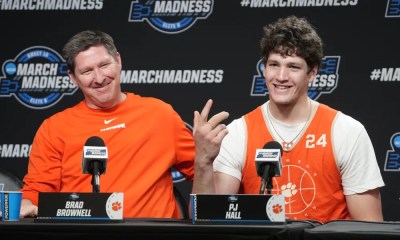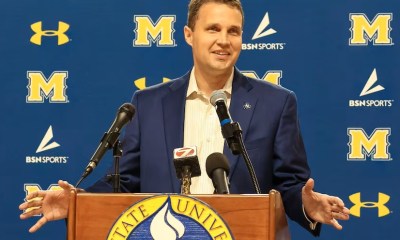
Zach Edey is destined to be remembered as one of the greatest players in modern college basketball history, if not all time. His career has been nothing short of fantastic, with the likelihood of securing his second sweep of the National Player of the Year awards in a matter of weeks. It would be the first time in 40 years, since Ralph Sampson that has happened.
While Matt Painter has effectively utilized Edey’s talents over the past two seasons, perhaps even maximized them, it’s hard to ignore the fact that he was severely underutilized during his sophomore year. It’s almost criminal to consider the limited playing time he received his first two seasons despite putting up historic per possession numbers, which ultimately deprived him of further greatness and recognition.
Zach Edey put up per possession numbers as good his sophmore year as either of the past two seasons.
| Min | PTS | REB | AST | BLK | |
|---|---|---|---|---|---|
| 2021-22 | 19.0 | 14.4 | 7.7 | 1.2 | 1.2 |
As you can see in the per possession numbers he’s basically the identical player he was today as a sophomore. Certainly a player that should have been on the court more than 19 minutes a game.
| Per 100 Possessions | REB | AST | BLK | PTS |
|---|---|---|---|---|
| 2020-21 | 18.1 | 1.5 | 4.4 | 35.5 |
| 2021-22 | 24.3 | 3.8 | 3.9 | 45.5 |
| 2022-23 | 25.3 | 3 | 4.2 | 43.8 |
| 2023-24 | 21.9 | 3.4 | 4.2 | 43.7 |
We disagreed with the lack of minutes, but at the time, there was a prevailing sentiment among the media that Edey couldn’t do what he was doing in extended minutes. We were hard on Painter even 2 years ago for not finding a way to get a player putting up all time historic production like Edey on the court more. He received very little pushback from most media outlets on his rotations though.
Contrary to the common belief that he couldn’t sustain same same level of performance over extended minutes that was obviously wrong. Insights from studies such as the Milsap Doctrine suggested that players with clearer, expanded starter roles often excel even more per possession than in back up roles. This enables them to warm up and find their rhythm without fear of immediate repercussions for mistakes and getting pulled. They aren’t looking over their shoulder playing scared essentially is the theory to explain this. When Edey did receive opportunities for extended playing time, statistical analyses revealed minimal decline in his per-possession performance the following season. It’s dropped slighting this season but that has more to do with playing the toughest Strength of Schedule in the Nation in our opinion.
As an impartial observer of college basketball, it was disheartening to witness what seemed like clear a mismanagement of talent. It wasn’t just a waste of Edey playing 19 minutes a game, it was also a complete waste of Trevion Williams playing 20.1 minutes. Both were playing as basically a platoon at center and never together. These weren’t just two best players on the team playing 5th and 6th man minutes, they were two of the best players in the entire country. Edey was 1st in the Nation that season in PER and Williams was 8th. It was an embarrassment of riches but unfair to both not to find a way to play them both more.
Trevion Williams
Williams was a stellar player, coming off a season where he earned 1st team All Big Ten honors and stood out as one of the nation’s top performers. His per-possession statistics improved even while he started coming off the bench. His performance wasn’t the issue even as his role decreased. At the time, it seemed crucial for the coach to figure out a way for both players to share the court, considering their distinct strengths and Williams’ exceptional ball handling and passing ability, arguably the best passing big in the country that year. Williams averaged 3 assist in 20 minutes a game at center, and that’s playing only 9 possession with Edey. Most importantly they didn’t work in the same areas on the court.

These are shots both players scored during that season. As evident, Williams primarily scored on drives to the basket, showcasing underrated speed in navigating past defenders, along with impressive ball-handling skills. 45% of his basketball come off 2 dribbles or more while Edey scored 78% of his baskets off 0 dribbles that year. These weren’t players competing for touches in the same areas of the court.
With Edey attracting considerable attention, Williams likely would have found opportunities for even easier baskets. Having both players on the court simultaneously would have very likely benefitted each other, given the double-teaming, defensive game planning, and individual attention they each commanded. The only plausible argument against it might be that Williams could have faced challenges in taking a power forward off the dribble as easily as he could have centers. However, we consider this argument weak given the immense defensive pressure that both Edey and Williams together could have exerted on opposing teams. Williams could have just backed down smaller power forwards too. Instead they played 9 possessions together the entire year.
Twin Towers
Many skilled coaches could and would have managed to allocate around 25 to 30 minutes of playing time for each player. That’s only a 10-minute overlap on the court. Could someone like Tommy Lloyd, who had two 7-footers last season, not have found a way to utilize these two for just 10 minutes together? While some may argue about defensive concerns, Zach Edey’s speed and agility is underrated. His performance at the NBA combine showcased that he’s not nearly as slow or unagile as perceived. He ran some drills faster than Kawhi Leonard, Carmelo Anthony, Kevin Durant and Derrek Rose. Moreover, his extraordinary length poses defensive challenges unlike any other player. Williams ran rather slow times at the combine, but no more than Azuolas Tubelis really. There are proven ways you can still play two centers together.
It was the most significant misuse of talent we can recall, both with Williams and Edey. While it likely wouldn’t have been the most ideal situation, and it was evident that Painter was reluctant to play them together, there comes a time when you have to make it happen. That point arrives much sooner than when both players are performing at top 10 levels nationally as they were. You should in our opinion always aim to field your best players regardless of poor fit; you must do so when they are clearly as good as they were that season. There maybe a diminishing return and fit issues to justify some rotation moves, but when they were as good as both of them were that season there is no real argument for playing them 20 or less minutes each. It’s imperative to figure a system at that point you can play both with even if that’s not how you want to play. It’s a failure as a coach to not adapt and play both tougher those 10 more minutes.
Oscar Tshiebwe and 2021-22
Tshiebwe was a worthy national player of the year winner, but when Edey got full command of a high minutes role he won the national player of the year awards easily even with Tshiebwe returning to defend them. Let’s assume in 2021-22 Edey had played 30 minutes a game. His numbers would have projected to be
22.7ppg, 12.1rpg, 1.9apg, 2.7bpg with the highest PER ever recorded in 20 years of history.
Purdue and Kentucky were both top 10 teams that season. Kentucky ranked 7th and Purde 10th. One could argue playing Edey and Williams more Purdue likely would have been even better than they were and, potentially #1 in the country like they have been most of the last two seasons with Edey playing 30+ minutes a game.
Even if you only played Edey 30 minutes that’s a likely scenerio and stopped playing Williams more than his back up. The team around him that season with Jaden Ivey, Sasha Stefanovic and Williams is certainly more talented than today and Edey was basically the same player statistically. A top three ranked Purdue with Edey with those stats likley wins easily.
Even if one were to argue that Williams’ presence might have slightly impacted Edey’s rebounding and scoring, a player averaging 20 points and 10 rebounds per game on the nation’s top team would still be a formidable contender for awards. Moreover, there’s a compelling case to be made that Edey could have scored even more efficiently with Williams on the court, benefiting from his adept passing and ability to draw defenders away and take more pressure off Edey. You could argue he would be more efficient even if the usage dropped some. Additionally, it’s unlikely that Williams would have significantly encroached on Edey’s rebounds or out rebounded him, as he would likely have been more inclined to secure boards others on the team were or been the statistical loser there.
Tshiebwe
17.4ppg, 15.1rpg, 1.1apg, 1.6spg, 1.8bpg….. 35.0 PER. .626% True Shooting, 13.3 BPM
Edey
22.7ppg, 12.1rpg, 1.9apg, 2.7bpg…..40.9 PER, .655% True Shooting, 13.1 BPM
Edey’s numbers would have objectively better, mirroring his performance over the last two seasons. Reflected in higher PER, True Shooting percentages, and an almost identical BPM to Tshiebwe. Purdue would have undoubtedly been a stronger team with him receiving more playing time, potentially positioning him for prestigious awards.
Instead, he logged just 19 minutes per game, while Williams, who was likely among the top 15 players that year as well only played 20 both cannibalizing each other. This allocation of playing time was a missed opportunity for both players, jeopardizing Edey’s potential legacy as a three-time national player of the year. Notably, Edey possesses the unique possibility of a Covid fifth year, which could have enabled him to achieve a fourth. While this opportunity remains to return, it appears less likely. However, the chance to etch one’s name in the annals of history with an unbreakable accomplishment unlikely to be replicated could have been a more compelling reason for him to return.
Related

Combat Sports
Tyson vs Paul: Experience and Exposure Clash

College Basketball
Top 300 Transfer Portal Basketball Rankings 2024

College Basketball
Grade Time: How Did Our Preseason Predictions Stack Up?

College Basketball
Top 300 Transfer Portal Basketball Rankings 2024

College Basketball
2024 Top 100 JUCO Basketball Recruiting Player Rankings

College Basketball
Looking Ahead: Way Way Too Early 2024-25 Rankings

College Basketball
Ranking Redux: Re-Ranking The 2023 Transfer Portal

College Basketball
Freshmen vs Portal Rankings: A Comprehensive Study

College Basketball
Summer Clearance: Bargain Bin Shopping in the Portal

More Featured
28.8%…The Michael Jordan 3 Point Debate

College Basketball
The Top 300 Returning Players












